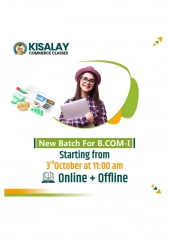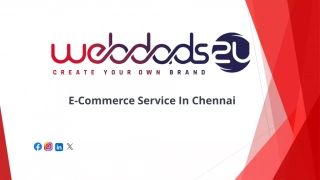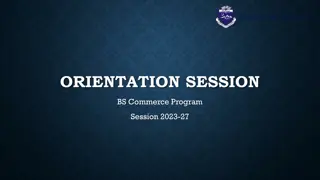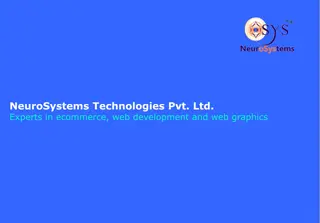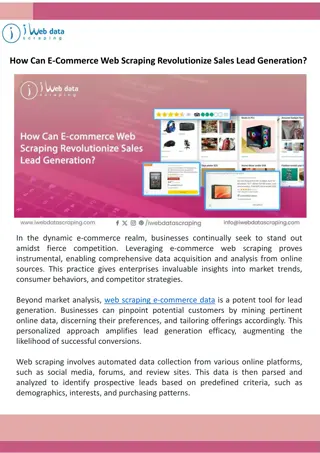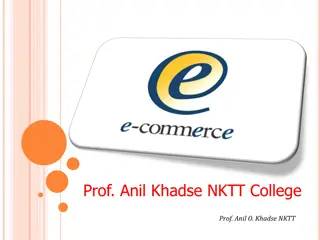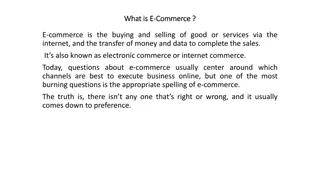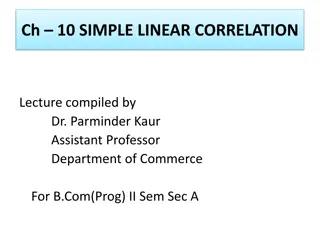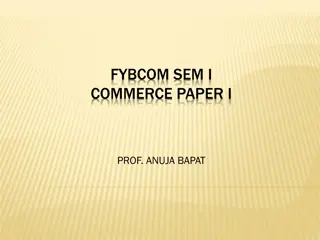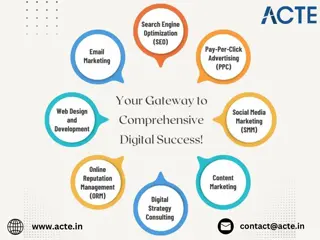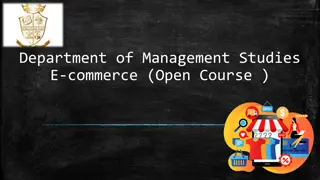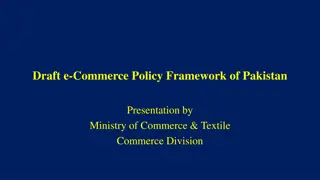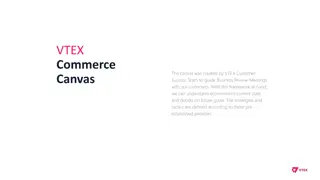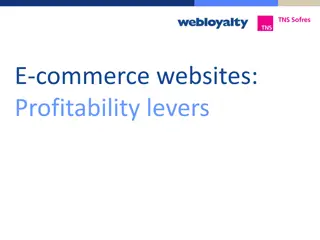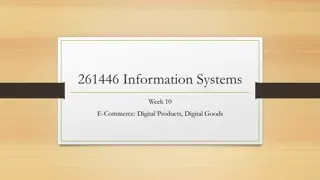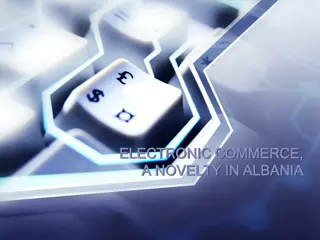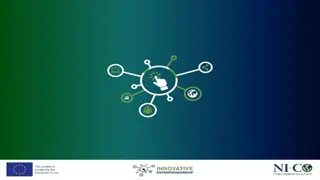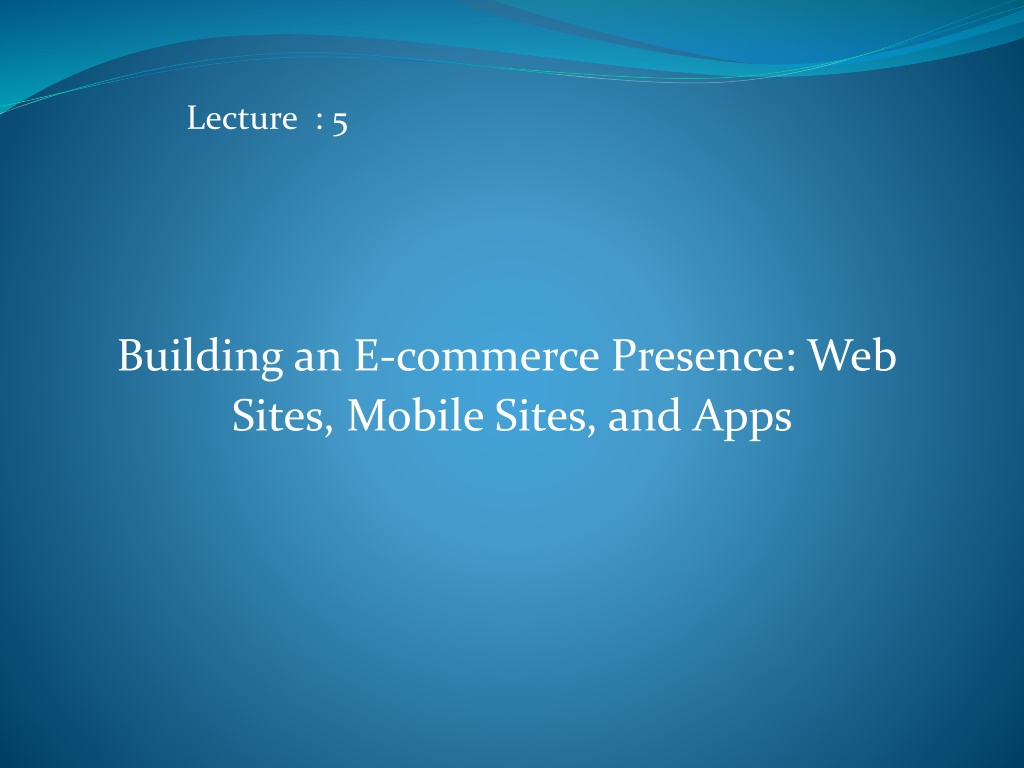
Building an E-commerce Presence: Strategies for Success
"Learn how to develop a successful e-commerce presence by understanding the shift to mobile and tablet-based activity, key management challenges, and the systems development life cycle. Make informed decisions on business objectives and technology to meet customer demands effectively."
Download Presentation

Please find below an Image/Link to download the presentation.
The content on the website is provided AS IS for your information and personal use only. It may not be sold, licensed, or shared on other websites without obtaining consent from the author. If you encounter any issues during the download, it is possible that the publisher has removed the file from their server.
You are allowed to download the files provided on this website for personal or commercial use, subject to the condition that they are used lawfully. All files are the property of their respective owners.
The content on the website is provided AS IS for your information and personal use only. It may not be sold, licensed, or shared on other websites without obtaining consent from the author.
E N D
Presentation Transcript
Lecture : 5 Building an E-commerce Presence: Web Sites, Mobile Sites, and Apps
Developing an E-commerce E-commerce has moved from being a PCs-centric activity on the Web to a mobile and tablet-based activity . In spite of 80% or more of e-commerce users using PCs. 80 . But smart phones and tablets are used by a majority of Internet users to shop and exchange goods and services, search for prices , the buying options spotting, and also through the social mediaand others . 1 2
. And the customers use these devices at different times during the day. Each of these are access points where you can meet the customers, and you have to think about how you develop thesedifferent virtual places. " . . " 1 3
Building an E-commerce Site A Systematic Approach Building a successful e-commerce presence requires deep understanding of business, technology, and social issues. There are two most important management challenges in building a successful e-commerce site you will need to consider : (1) developing a clear understanding of your business objectives (2) knowing how to choose the right technology to achieve those objectives. 1 4
The first challenge : requires you to build a plan for developing. The second challenge : requires you to understand some of the basic elements of e-commerce infrastructure such as cost, and constraints. . .... 1 5
You will also need to make decisions about hardware, software, and telecommunications infrastructure. The demands of your customers should limiting your choices of technology. The customers will want technology that enables them to find what they want easily, view the product, buy the product, and then receive the product from your warehouses quickly. . . . 1 6
Web Site Systems Development Life Cycle To build an e-commerce site, you will need a series of steps ( methodology) . One of this methodologies is the systems development lifecycle. The systems development life cycle (SDLC) is a methodology for understanding the business objectives of any system and designing proper solution for it . . ) . ( . 1 7
Web Site Systems Development Life Cycle Steps There are five major steps for an e-commerce Web site development life cycle : 1- Planning / Systems analysis 2- Systems design 3-Building the system 4- Testing 5- Implementation 1 8
System Analysis/Planning: Identifying Business Objectives, System Functionality, and Information Requirements : / 1- Business objectives: a list of capabilities you want your site to have . . : 1 - 2- System functionalities: a list of the types of information system capabilities you will need to achieve your business objectives . : 2 - . 1 10
3- Information requirements: the information elements that the system must produce in order to achieve the business objectives. : 3 - . 1 11
Dynamic Page Generation Tools Dynamic page generation: contents of Web page are stored as objects in a database rather than being hard-coded in HTML, and are fetched when needed from database. : Tools include CGI (Common Gateway Interface), ASP (Active Server Pages), JSP (Java Server Pages), etc. . ) ) ( ) ( ( 1 12
Choosing the Hardware for an E-commerce Site Hardware platform: refers to all the underlying computing equipment that the system uses to achieve e-commerce functionality . : . Important to understand the different factors that affect speed, capacity, and scalability of a site. . 1 13
Requirements of the Site-Building Main things where you will need to make decision in building an e-commerce site include: 1- Notions of site design 2-Human resources. 3- Business team that has the skills set to build and manage the site. 4- Hardware 5- Software. 6- Telecommunications . 1 14
1 15
Systems Design : Hardware and Software Platforms System design can be broken down into two parts: 1/Logical design 2/Physical design E-commerce Server Functionality The basic functionality needed foronline sales, including: 1.Online catalog 2.Shopping cart 3.Smart card 1 16
Developing a Mobile Web Site and Building Mobile Applications Today, building a Mobile Web site is just one part of developing an e-commerce presence. Given that almost 60% of all Internet users access the Web at least part of the time from mobile devices, firms today need to develop mobile Web sites, mobile Web apps, in order to interact with customers, suppliers, and employees. At mobile Web site the users can move quickly and find what they want . Now most large firms have mobile Web sites . 1 17
Mobile Web Presence: Design Considerations Designing a mobile presence is somewhat different from traditional desktop Web site design, because of different hardware, software . Designers need to take mobile platform constraints into account, such as file sizes should be kept smaller , powerful graphics, and compressing of the images, simplify choice boxes and lists so the user can easily scroll and touch-select the options . 1 18
1 20
Internet and Web on which e-commerce is built include: 1.E-mail 2. Search engines 3.Intelligent agents (bots) 4.Chat 5.Music, video and other standard files 6.Streaming media 7- Cookies 1 21
(1)E-mail 1-Most used application of the Internet uses a series of protocols to enable messages containing text, images, sound, video clips, etc to be transferred from one Internet user to another . 2-Can be an effective marketing tool . ( 1 ) 1 - . . 2 - 1 22
(2)Search Engines 1-Identifies Web pages that appear to match keywords (queries) entered by a user, and provides list of best matches based on one or moreof avarietyof techniques 2-Can be an effective marketing tool (shopping tools) (search engine marketing) ( 2 ) 1 - ) ( ) ( ) ( 2 - 1 23
(3)Intelligent Agents (Bots) Software programs that gather and/or filter information on a specific topic and then providea list of results Types include search bot, shopping bot, Web monitoring bot, news bot, chatter bot (4) Chat: Used in e-commerce to enables users to communicate via computer in real time . (5) Music, video, and other standard files: routinely used for marketing and advertising purposes . 1 24
(6) Streaming media: enables music, video and other large files to be sent to users in chunks . (7) Cookies: small text file stored on user s computer with information about the user that can be accessed by Web site the next time user returns to the site . : ( 7 ) . 1 25
Planning to create an e-commerce website Planning for the site is one of the most important things to keep in mind before starting tocreate awebsite . There are some guidelines that enable beginners to create a successful site such as: : 1- Designing a sitewhere selling tools are available 2. Supportcustomers and help them do regular business 1 26
3 - Ensure the continuity of the site and not stop for any reason . 4 - Promotion of the site using appropriate means . 5. Provide reference can be returned to the customer in case of loss of service . 6 - Determine how to pay with the provision of facilities for the customer . 1 27
Terminologies related tolecture 1- (HTML) : HyperText Markup Language 2-( CGI) : Common Gateway Interface 3-( ASP ) : Active Server Pages 4- ( JSP): Java Server Pages 5 - (SDLC): Systems Development Life Cycle 1 28

